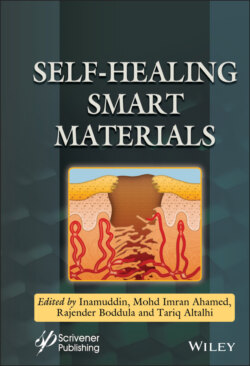Читать книгу Self-Healing Smart Materials - Группа авторов - Страница 2
Table of Contents
Оглавление1 Cover
2 Title Page
3 Copyright
4 Preface
5 1 Self-Healing Polymer Coatings 1.1 Introduction 1.2 Extrinsic Self-Healing Polymer Coatings 1.3 Intrinsic Self-Healing Polymer Coatings 1.4 Remote Activation of Self-Healing 1.5 Perspectives and Challenges References
6 2 Smart Phenolics for Self-Healing and Shape Memory Applications 2.1 Introduction 2.2 Self-Healable Polybenzoxazines 2.3 Benzoxazine Resins for Shape Memory Applications 2.4 Conclusion References
7 3 Self-Healable Elastomers 3.1 Introduction 3.2 Self-Healing in Elastomers 3.3 Particular Cases in Different Elastomers References
8 4 Self-Healable Tires 4.1 Introduction 4.2 Self-Healable Rubber 4.3 Promising Strategy for Self-Healing Rubber-Based Material 4.4 Conclusion References
9 5 Self-Healing Bacterial Cementitious Composites 5.1 Introduction 5.2 Biomineralization for Self-Healing 5.3 Strategies to Enhance the Performance of Bacterial Self-Healing 5.4 Evaluation of Factors Affecting Bacterial Self-Healing 5.5 Conclusion, Future Prospective & Challenges References
10 6 Self-Healable Solar Cells: Recent Insights and Challenges 6.1 Introduction 6.2 Functional Mechanism of Protection Approaches 6.3 Advanced Self-Healable Polymeric Materials 6.4 Shape Memory Materials 6.5 Self-Healable Solar Cells 6.6 Conclusions References
11 7 Self-Healable Core–Shell Nanofibers 7.1 Introduction 7.2 Self-Healing Polymers in Fabrication of Core–Shell Nanofibers 7.3 Strategies for Core–Shell Nanofibers Fabrication 7.4 Methods of Fabrication of Self-Healing Core–Shell Nanofibers 7.5 Self-Healing in Laminated Composite 7.6 Beneficial Self-Repairing Systems on Basis of Core–Shell Nanofibers 7.7 Conclusion References
12 8 Intrinsic Self-Healing Materials 8.1 Introduction 8.2 Inverse Reactions and Chain Recombination 8.3 Reversible (Covalent) Bonds 8.4 Supramolecular Interactions 8.5 Conclusion References
13 9 Self-Healable Catalysis 9.1 Introduction 9.2 Self-Healable Catalysis Applications 9.3 Conclusion References
14 10 Self-Healing Materials in Corrosion Protection 10.1 Introduction 10.2 Self-Healing Definition 10.3 Inhibition of the Corroded Regions Thanks to the 10.4 The Imprisonment and Physical Release of the Inhibitor 10.5 Healing Using Polymerizable Agents 10.6 Conclusion and Outlook References
15 11 Self-Healable Conductive Materials 11.1 Introduction 11.2 Self-Healing Materials 11.3 Self-Healing Conductive Materials 11.4 Conclusion References
16 12 Self-Healable Artificial Skin 12.1 Introduction 12.2 Preparation and Properties of Artificial Skin 12.3 Applications of Electronic Skin 12.4 Conclusion References
17 13 Self-Healing Smart Composites 13.1 Introduction 13.2 Self-Healing Mechanisms and its Classifications 13.3 Self-Healing of Thermoplastic Materials 13.4 Self-Healing of Thermosetting Materials 13.5 Conclusions and Future Study References
18 14 Stimuli-Responsive Self-Healable Materials 14.1 Self-Healing Materials 14.2 Synthesis of S-H Materials 14.3 Types of S-H Materials 14.4 Need for Stimuli-Responsive Shape Memory (S-RSM) Materials 14.5 Stimuli-Responsive or Nonautonomous S-H Materials 14.6 Commercialization and Challenges 14.7 Conclusions References
19 15 Mechanically-Induced Self-Healable Materials 15.1 Introduction 15.2 Mechanically-Induced Self-Healing Based on Gel 15.3 Mechanically-Induced Self-Healing Based on Crystals 15.4 Mechanically-Induced Self-Healing Based on Composites 15.5 Mechanically-Induced Self-Healing for Corrosion 15.6 Conclusion References
20 16 Self-Healing Materials in Robotics 16.1 Introduction 16.2 Chemistry of Self-Healing (S-H) Materials 16.3 Working of Self-Healing (S-H) Material 16.4 Application of Self-Healing Robots 16.5 Approaches to Self-Healing 16.6 Material Application and Damage Resilience Mechanism 16.7 Conclusion References
21 17 Self-Healing Materials in Aerospace Applications 17.1 Introduction 17.2 Classification of Self-Healing Materials 17.3 Self-Healing Materials in Aerospace Applications 17.4 Conclusion References
22 18 Bio-Inspired Self-Healable Materials 18.1 Introduction 18.2 Repairing and Healing the Damage 18.3 A Systematic Biomimetic Approach 18.4 Self-Healable Materials: Case Studies 18.5 Applications of Bio-Inspired Self-Healable Materials—Examples 18.6 Conclusions and Outlook References
23 19 Self-Healable Batteries 19.1 Introduction 19.2 Development of Self-Healing Materials 19.3 Self-Healing Batteries 19.4 Conclusions References
24 20 Self-Healing in Bleeding Composites 20.1 Introduction 20.2 Intrinsic and Extrinsic Self-Healing Materials and Their Repairing Approaches 20.3 Strategies of Self-Healing in Engineered Materials 20.4 Healing Agents, Comparison With Biological Phenomenon and Bleeding Mechanism in Self-Healing Composite Materials 20.5 Advantages and Disadvantages of Self-Repairing Bleeding Composite Materials 20.6 Conclusion References
25 21 Self-Healing Polymers 21.1 Introduction 21.2 General Overview on Self-Healing Materials 21.3 Design of Self-Healing 21.4 Application of Self-Healing Materials 21.5 Specific Examples of Self-Healing Polymer 21.6 Conclusion and Recommendations References
26 Index
27 End User License Agreement
